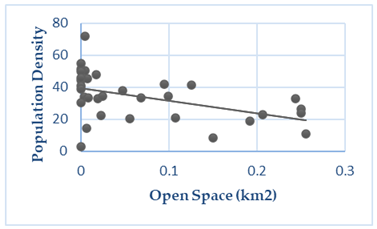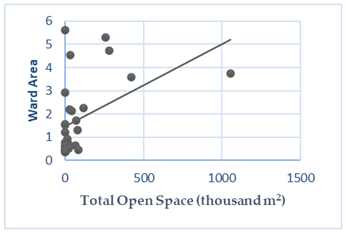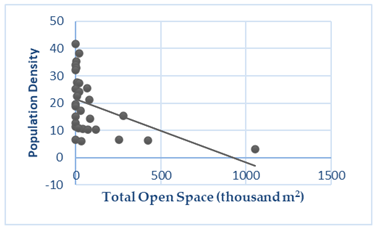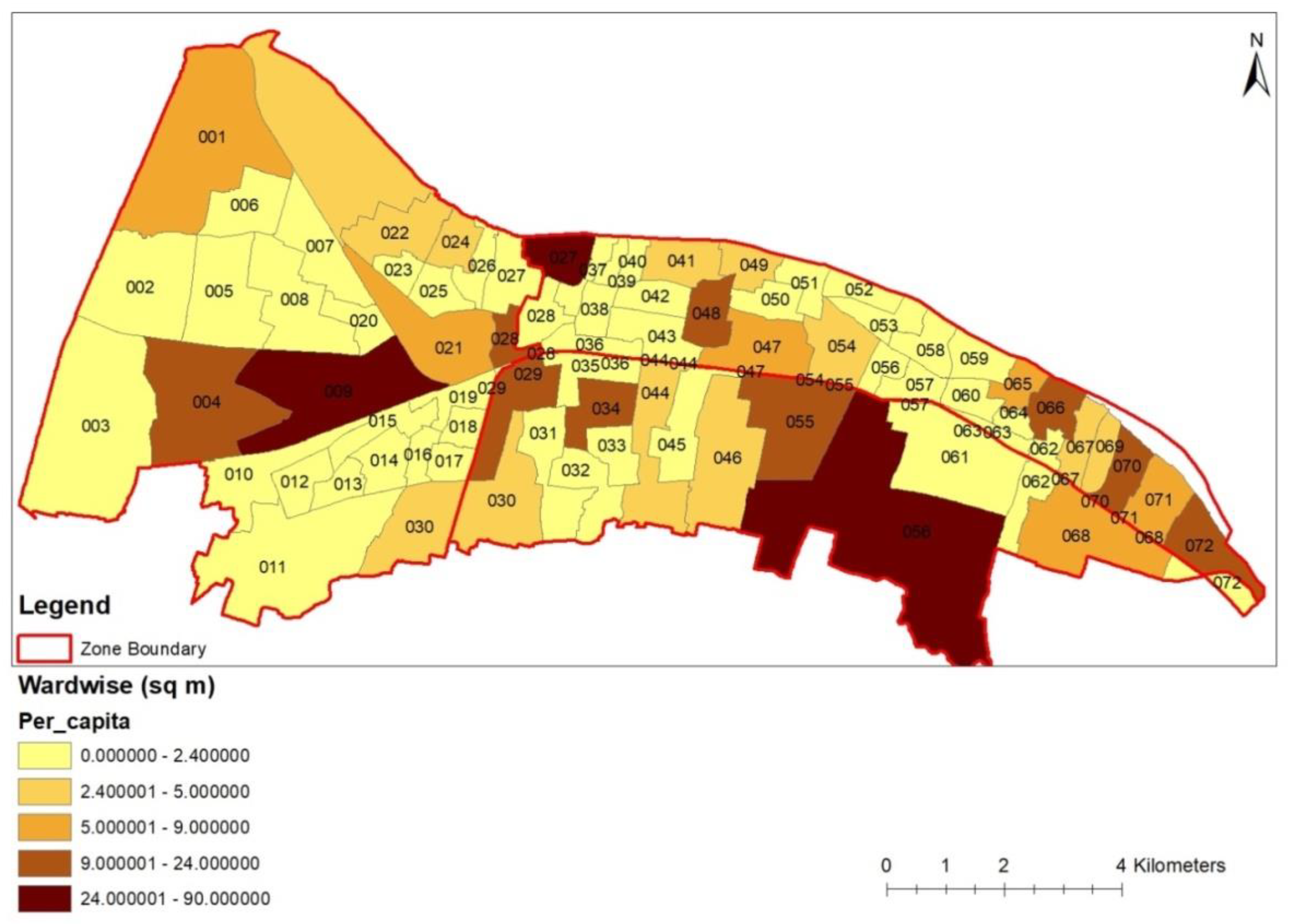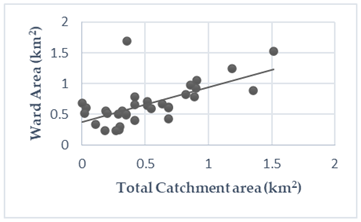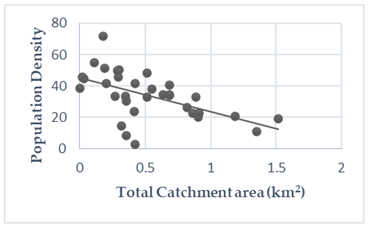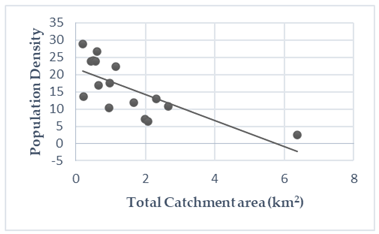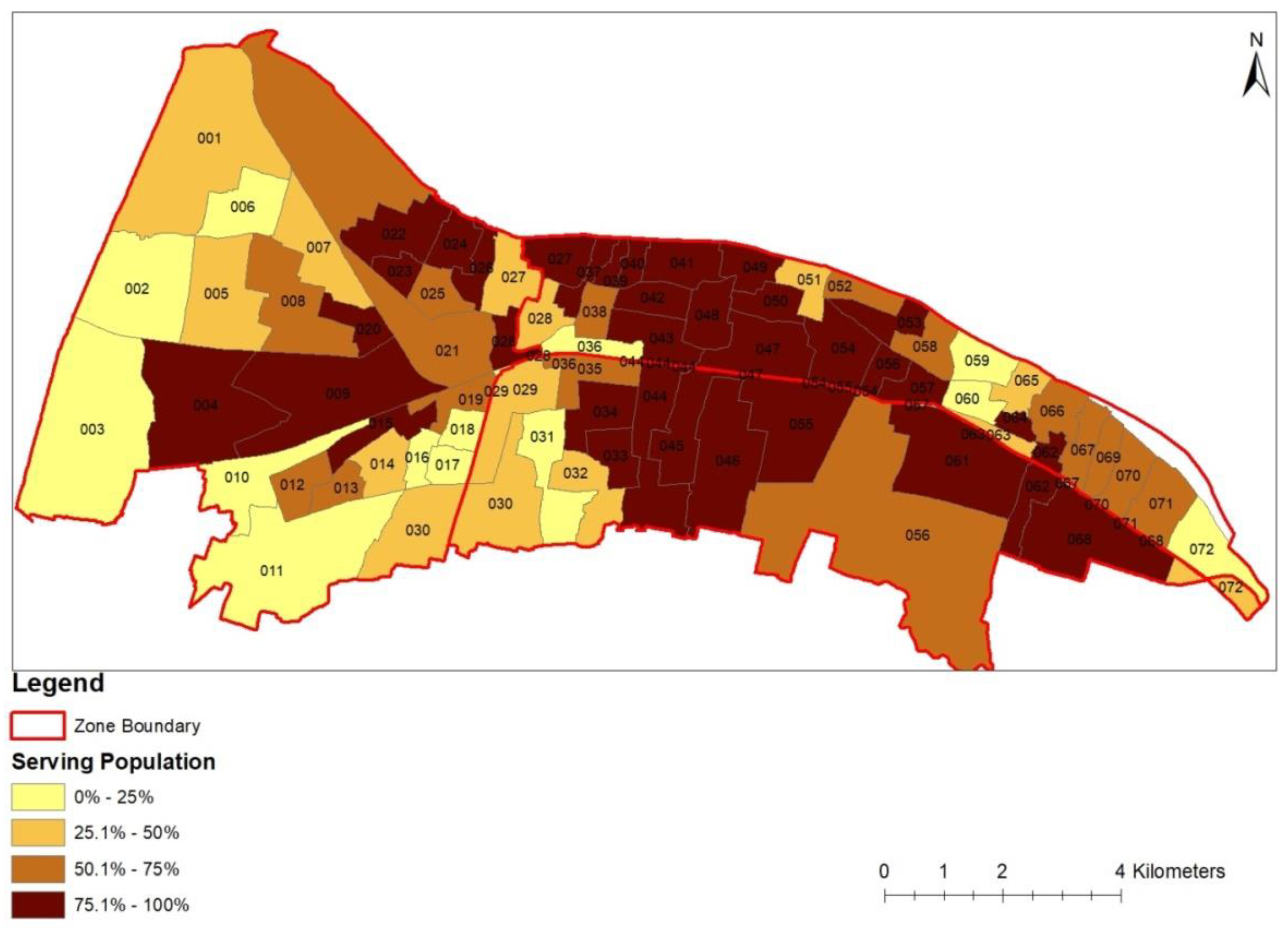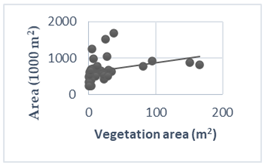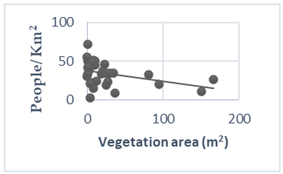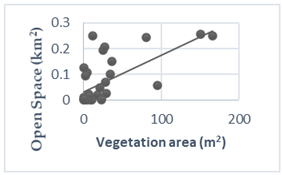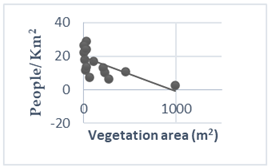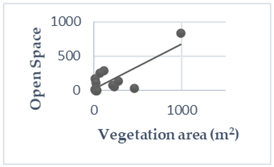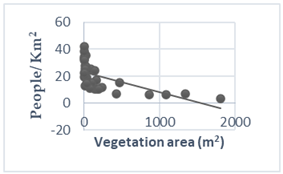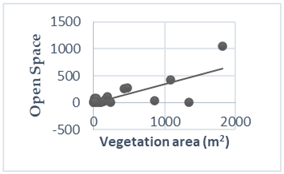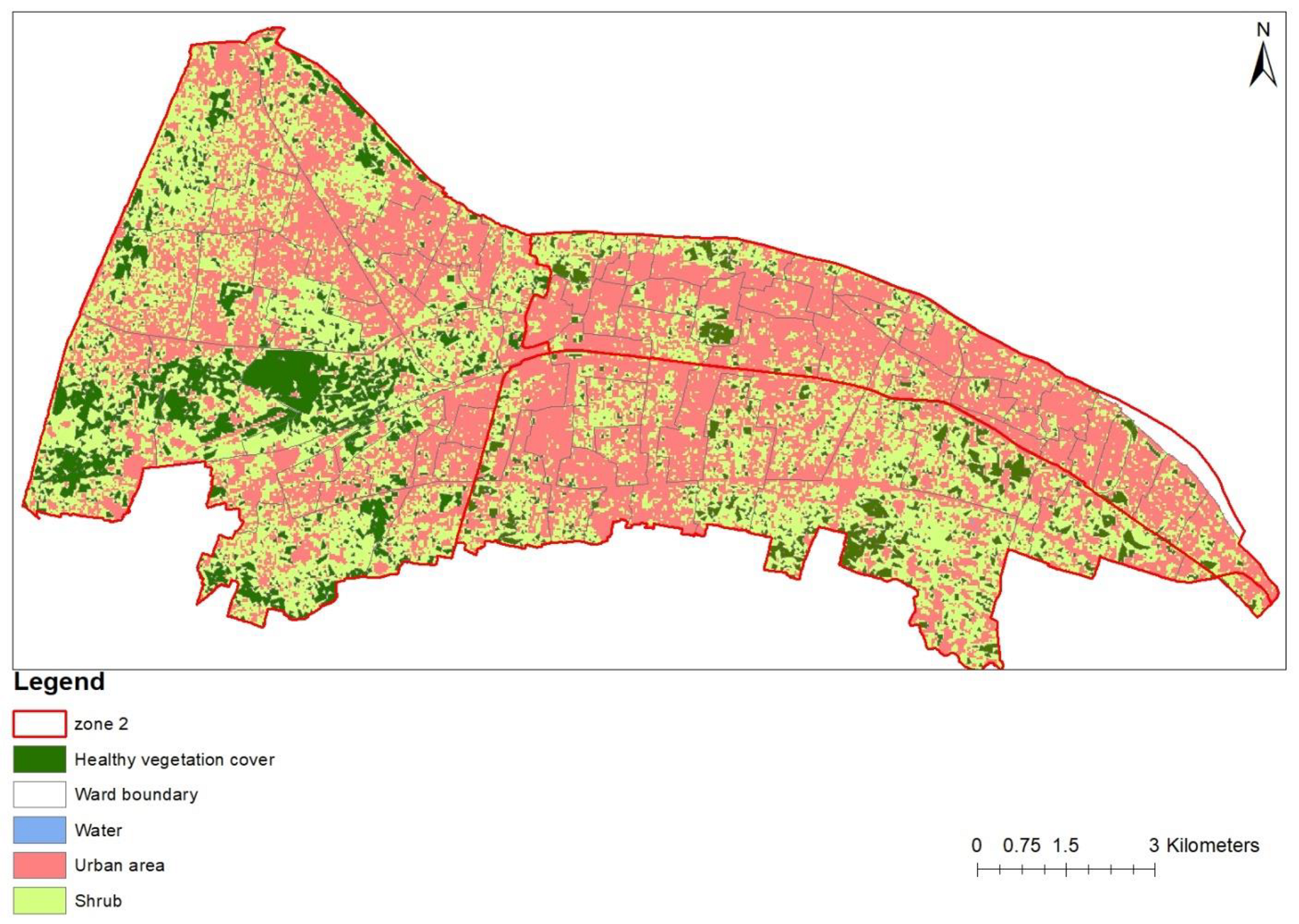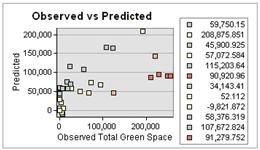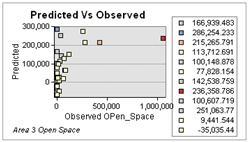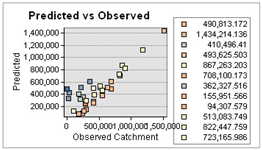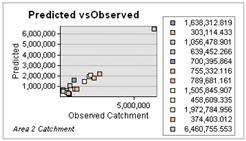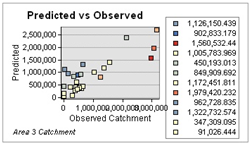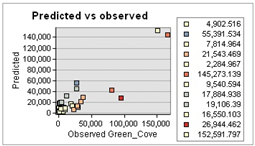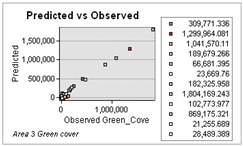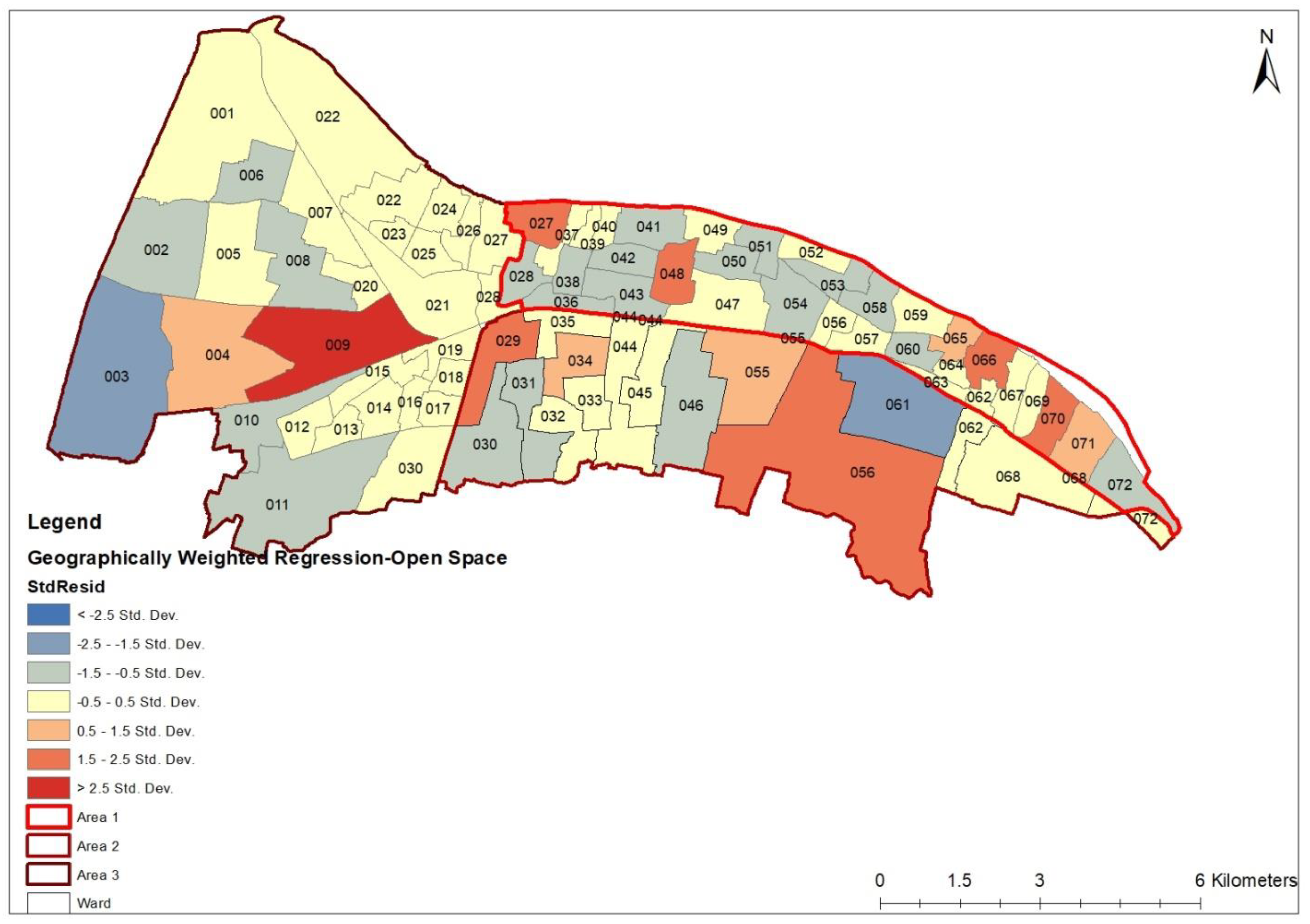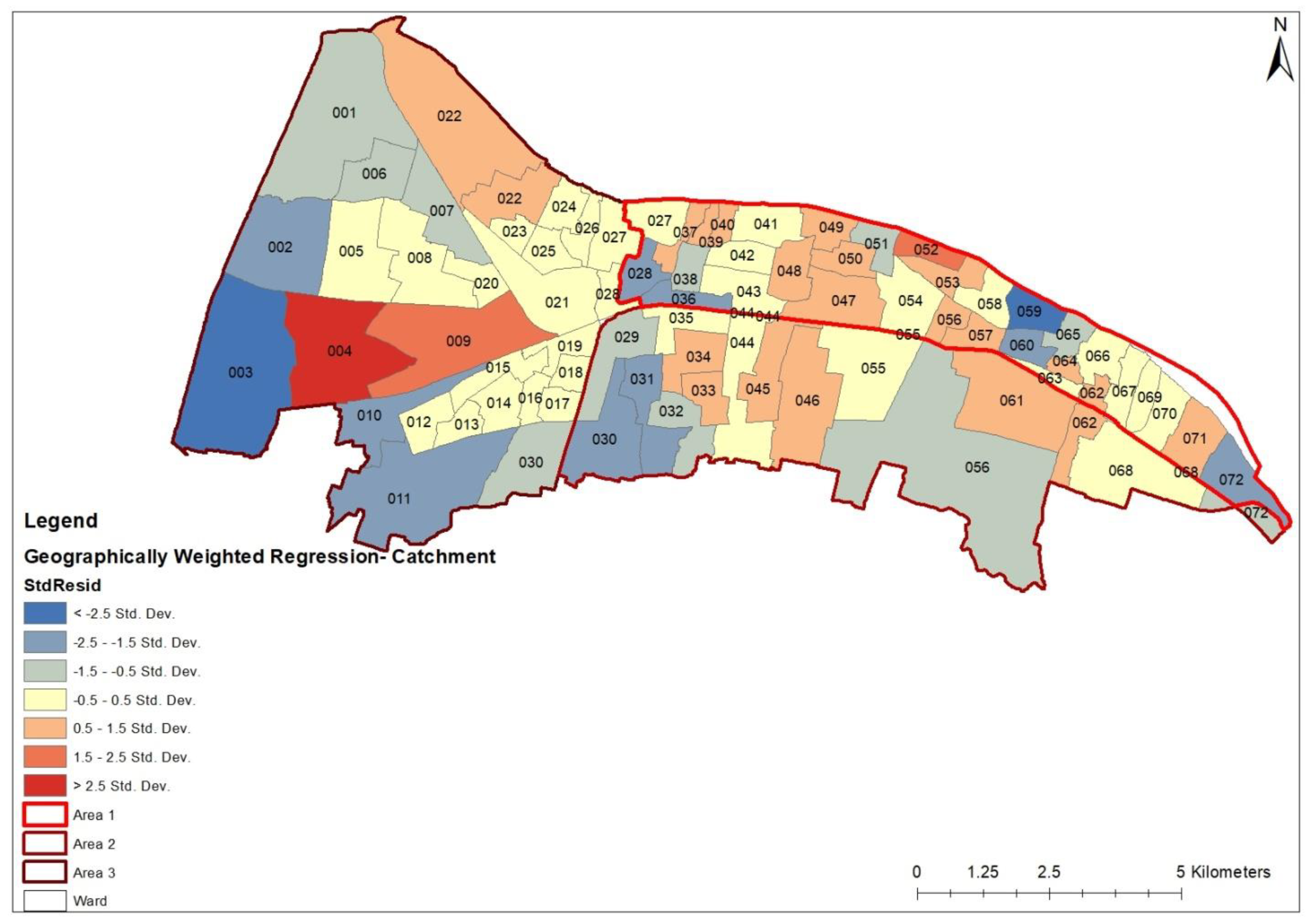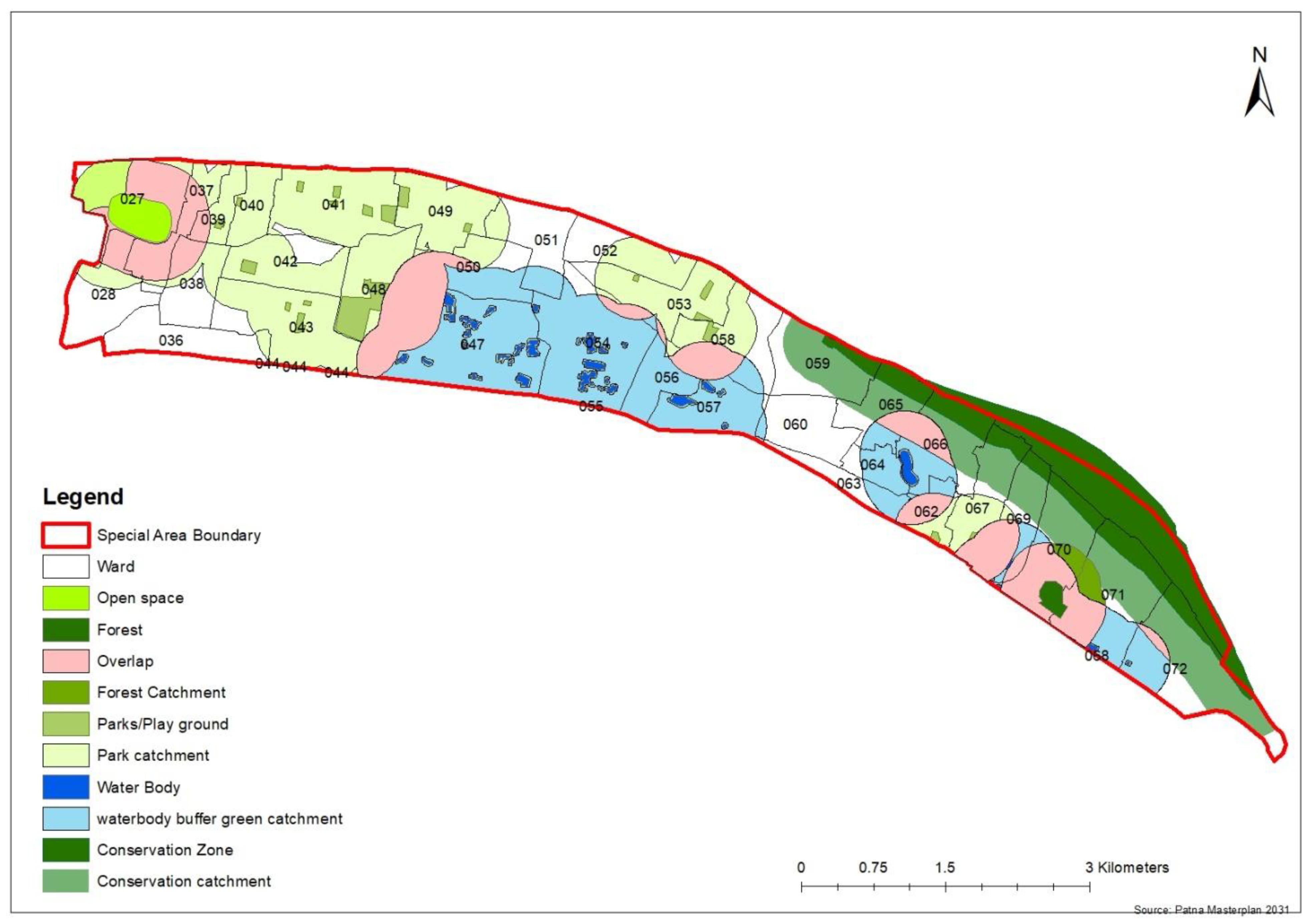1. Introduction
Urban green open spaces play a significant role in any city development as they provides an opportunity for physical activity, social interaction, and enjoyment of nature, and offer a unique environmental setting within the urban area and, most notably, the urban ecology [
1]. Different disciplines have used various definitions from their professional concept for urban green open spaces, such as horticultural green land system, urban green land system, ecological green land system, and urban green space, green open space, and urban green open space [
2,
3]. All open spaces which are publicly accessible are referred to as public open spaces, including green or civic. Moreover, in many definitions, urban green space is all types of public or private open spaces in urban areas that are entirely or mostly covered with vegetation [
4,
5]. Urban green open spaces, as per Wang [
3], are considered vegetation-covered public areas used for social interaction and physical activity. As urban green spaces have multiple definitions, in this paper, the definition of urban green open space can be understood as urban open spaces having vegetation and accessible to the public. It refers to the human-built environment, such as an urban park, garden, or any green space, and serves for community needs, social interaction, and joint activities [
6]. It is combination of the term urban green space, which comprises areas covered with vegetation, and public open space, which is a publicly accessible part of urban land and contributes to the urban landscape [
3,
5,
6]. It constitutes the most crucial component of urban spaces as it comprises parks, forests, playgrounds, riparian areas such as riverbanks, lakes, green promenades, trails, and nature conservation areas [
2,
7,
8]. It helps mitigate the heat island effect in urban areas with the help of evapotranspiration and shading effects [
9,
10]. It helps in improving air quality, flood control, and reducing noise pollution [
11,
12]. The urban green open space can also refer to an urban open space. It has a similar definition in terms of uses, but it is limited to the areas with green cover in the urban open space that is publicly accessible [
5,
6].
Urban green open spaces provide many functions in an urban context that benefit people’s quality of life [
13]. Despite knowing the importance and benefits, such as physical, psychological, social, environmental, and economic benefits [
14], urban green open spaces there will be a shortage due to rapid urbanization and an increase in the population [
14]. Urban green open spaces are very vulnerable due to the sudden loss of vegetation cover and change in vegetation in the built-up areas in Indian cities [
15,
16]. This built-up area is increasing and will be continue to increase at a rapid pace. The problem can be seen with the help of demographic change projection for the future. This says that the urban population is projected to increase by 18.5% from 35% in 2020 to 53.5% in 2050 [
17], which tells that more than half of the population will live in urban areas by 2050 in India (see
Table 1). This change will affect the urban agglomeration and increase the population density from 464 people/km
2 in 2010 to 550 people/km
2 in 2050. The number of cities with a population of at least a million in India increased from 35 in 2001 to 53 in 2011, and there will be six cities with a population over 10 million and more than 100 cities with a population of at least a million by 2030 [
18]. By 2050, India will be the most populous country in the world [
17].
These demographic changes have resulted in a significant decrease in green spaces across many cities in India and they are further decreasing with growing urbanization and population increase [
19]. The loss of green spaces and environmental degradation are likely to increase due to an increase in population and density. There is a lack of per capita availability of urban green open spaces in most Indian cities [
20]. Indian megacities such as Bangalore, Hyderabad, and Kolkata have lost many open spaces, urban wetlands, and water bodies because of urban sprawl [
16,
20]. It has been observed that this pressure of urbanization and population increase is greater on the older cities and settlements. As per the study by Rao and Kumar, the old core area of a city has less open space because of population pressure compared to the new areas. Additionally, it is not adequately distributed [
21,
22]. The open space standard should be fulfilled on different levels, such as community, district, and city levels, as per Urban and Regional Development Plans Formulation and Implementation (URDPFI) guidelines in India [
23]. However, the open space assessment is per capita, not focusing on the distribution in all levels in Indian cities [
24]. A lot of qualitative and quantitative research has been carried out to assess urban green open spaces in cities such as Nagpur, Bhopal, Delhi, Kolkata, and Bangalore [
8,
16,
22,
25]. As per Senik [
26], a qualitative evaluation has been carried out for the open green space planning approach. Ahirrao carried out an assessment, and the qualitative approach has been assessed based on perception and was limited only to the parks of Nagpur [
8]. In India, quantification and distribution of UGS have not been fully incorporated in urban planning due to a lack of detailed assessment [
27]. A limited study has been carried out on the quantitative change in urban green space with urbanization. In addition, the study shows the urban green change based on remote sensing with an assessment based on the green cover LULC change [
16]. A very limited study was carried out to assess the urban green open space as per the definition given in the paper. Moreover, no assessment study has been carried out in Indian cities on urban green open space based on the growth pattern and the identified parameters. The assessment of only the green cover will not give the actual picture as some urban green open spaces can fall into private or restricted areas. Moreover, they might not be accessible to the public for social interaction and physical activities, as defined in this paper. A quantitative and qualitative assessment study of urban green open spaces has yet to be carried out based on the city’s growth pattern, especially for older and tier 2 metro cities. This study is required to understand the open space distribution of an Indian city at different levels (micro and meso level) and assess the distribution with respect to the city’s growth.
The main aim of this research is to assess the open space at the micro and meso level of a city based on the growth pattern.
To assess urban green open space, it is required to understand the standards related to urban green open space and assessment parameters in India and abroad. As per the Urban Green Guideline 2014 by the Government of India, classification is carried out based on hierarchy and uses, which are reserved forest, protected forest, national park, district park, playground, green belt buffer, and green strip. As per the URDPFI guideline, the city should have 31.6 hectares of open space per a population of one lakh for the community level, which will be 3.16 m
2/capita, and 183 hectares of open space per a population of five lakh for the district level, which will be 3.66 m
2/capita. In addition, the metropolitan city should have 20–25% green areas, including recreational space, organized green space, and other common open spaces, including vacant land, open spaces including flood plains, etc. [
23].
India and many Asian countries follow the quantitative assessment standard, which is the per capita green space, unlike other European, Australian, and American countries that also follow accessibility and quality for their assessment [
24]. In Britain, as per the National Playing Field Association (NPFA), it is 24 m
2 per capita, and in the USA as per the National Recreation Park Association standard, 40 m
2 per capita is required. As per LEED-ND, more than 20 m
2/capita or 1.25 hectares/1000 residents within 250 m should be provided. The WHO standard recommends 9 m
2/capita.
As per a study by Dhanpal in 2014, regarding the per capita green space in major cities in India, only a few have been able to provide more per capita green space than the international standard. Jaipur (20 m
2/capita), Gandhinagar (147 m
2/capita), Chandigarh (54.45 m
2/capita), and Bangalore (17.79 m
2/capita) are among the few cities which have higher than standard open space requirements [
19].
In terms of the assessment parameters, as in India, open space assessment is carried out on a quantity basis that is derived from population and area concerning open space [
7,
23,
28]. However, when we compare with other European, Australian, and American countries they also assess the open space based on quantity, that is, per capita open space [
19,
20,
23,
24], and also accessibility, that is, the catchment area of the open space [
19,
24], and the served population and the quality, that is, the healthy vegetation cover [
24,
25]. The problem of lack of availability of open space is not limited to the tier 1 megacities such as Bangalore, Hyderabad, Kolkata, and Delhi, as it is also seen in tier 2 metro cities, and Patna is not an exception [
13,
20,
21,
22].
The Patna Municipal Corporation area has a population of 1,684,222, and an area of 108.164 km
2 which has risen 48.97% from 1991 to 2001 and 32.53% from 2001 to 2011 [
18]. In the study carried out by Asraf and Ghose in 2015, the urban green space was reduced to 16.28 km
2 in 2014 from 50.4 km
2 in 1993 [
13]. This study showed the green cover, which also included private land. Patna has lost many green spaces and water bodies in the past few decades because of encroachment and urban sprawl [
13,
21]. As per the existing master plan, the per capita green space is 2.43 m
2 per capita [
28]. This 2.43 m
2 per capita open space shows the overall open space of Patna; at the micro level, we can see fewer open spaces in the core city area compared to the new areas [
21], which means some areas will have less than 2.43 m
2 per capita of open space. Patna City in context with open space is shown in
Figure 1.
As per a study by Kumar, the distribution of open space is missing for Patna City. Additionally, as per Rao and Kumar, their study shows that the core city area of older cities such as Patna and Bhopal has less open space because of population pressure than outgrowth or new areas [
21,
22].
This this research suggests that because of increasing population pressure and urbanization, the open space standard is lower in the core city area or the old city area compared to the new development [
21,
22]. However, this research does not explain whether the changes are proportional to the change in the city’s growth pattern, and there is a need to understand the lack on the micro level (ward-wise) and meso level (zone-wise). In addition, the assessment parameter for the urban green open spaces especially in Indian cities is very limited to a quantitative approach, as per the study by Maharina [
24] and other European and Australian countries, in which the open space assessment has to be carried out based on quantity, quality, and accessibility.
Based on the need for study, previous literature study, and the aim of this research, in this paper, we are trying to answer two questions based on the identified parameters:
4. Results
From the georeferenced Patna municipal boundary and open space map of the Patna Master Plan on ArcGIS, the parameters and variables to calculate the per capita open space, ward density, total open space, and the NDVI mapping with the Landsat 8 image (July 2022) to know the vegetation cover are given in
Table 4.
One of the limitations of the study is that the population data were from 2011, as the new census for 2021 was not yet available from the Government of India. Additionally, acquiring the micro-level population data (ward level) was also not feasible as the number of wards as per the census in 2001 was 42, which has changed to 75 wards as per the latest 2021 data, and the ward boundaries and area have been changed since then. So, the regression and quantitative analysis were carried out on the basis of 2011 population data. However, to obtain the result of the current and future years, the assumption of population data was taken on the basis of the population projection of 2030 by the City Development Plan, only for the overall three areas of the meso level. The micro-level regression analysis was not possible because of the limitation in projecting the ward-level population due to the difference in the number of wards and area boundaries within the decade (2001–2011). For the meso-level analysis based on the quantity and accessibility, the city-level population projection data could be used. As per the City Development Plan 2010 and Patna Master Plan, the population of Patna will reach thirty lakh according to the linear method, so the growth percentage from 2011 to 2030 is 78.2% [
35]. For the different study areas, population projection is given in
Table 5.
Based on the population projection as per
Table 5,
Table 6 and
Table 7, the per capita open space and served population based on the proposed open space map as per the Patna Master Plan 2031 were calculated.
As per data extracted from the secondary sources, the variables used in the study are total urban green open space, total area, population density, healthy vegetation cover, and open space per capita. The following data reveal that the special area has more than double the population density than the other two. However, it has mostly similar per capita open space compared to Area 3. Zone 2 has comparatively more per capita open space than the other two (
Table 5). As per the projected population in
Table 6 and
Table 7, Area 2 (4.01 m
2/capita) had a good amount of open space compared to Area 1 (2.5 m
2/capita) and Area 3 (2.8 m
2/capita) in 2021, but it has close to the standard open space for recreational use, that is, 3.13 m
2/capita, for the 2030 projected population. Areas 1 and 3 have less than the standard open space requirement for recreational use for the projected population (see
Table 6 and
Table 7).
In terms of accessibility, more populations have access in Area 1 than Areas 2 and 3. The served population in Area 1 is 485,182 (73.82%), that of Area 2 is 246,299 (68.8%), and that of Area 3 is 32,1920 (48.3%). For the projected population of 2030, Area 2 serves 72%, then Area 1 serves 69%, and, finally, Area 3 serves 45% of the population. The served population is calculated by the following formula:
The healthy vegetation cover was derived from remote sensing data of Landsat 8 in July 2022 with the help of the normalized difference vegetation index (NDVI). For the Landsat 8 image, band 4 and band 5 were used in the NDVI. The formula for the NDVI is:
The healthy vegetation range was taken as 0.3 and above in supervised classification. As per the data from supervised classification, Area 3 has more vegetation than Areas 1 and 2.
This is for an overall understanding of the different meso-level areas based on different parameters. Now, the micro-level analysis at the ward level of all three meso levels is given, and the correlation between the variables for the given parameters is given in
Table 8,
Table 9 and
Table 10.
4.1. Quantitative Analysis
This part of the analysis shows the correlation with the variables. We have used Pearson correlation analysis to check the correlation between variables and also the strength of the correlation. As discussed previously for selecting parameters, the independent variable is open space and the dependent variables are ward area and population density.
Ward area has a positive relationship in Zones 1, 2, and 3, with the open space having r = 0.58, 0.89, 0.45, respectively, whereas population density has a negative relationship with open space with r = −0.497, −0.615, −0.45, respectively (see
Table 8). This shows that the open space area increases as the ward area increases, but it decreases as the population density increases. Open space’s negative relationship with population density shows that, in wards where the population is larger, the open space is smaller, so this has to improve. By comparing with the strength in the variables, in Zone 2, the strength of “r” is higher in both cases, then Zone 1, and then Zone 3. On the map (
Figure 3), it is visible that many areas have less than the city-level per capita amount of open space, i.e., 2.4 m
2/capita, especially in Area 3.
Table 8.
Quantitative and correlation analysis of different Zones.
Figure 3.
Map of Per Capita ward-wise distribution of Patna. (Source: Census Of India—Population data, Patna Municipal Corporation ward boundary and corporation boundary and area, Master Plan 2031—open space location, map generated in ArcMap 10.4.1).
Figure 3.
Map of Per Capita ward-wise distribution of Patna. (Source: Census Of India—Population data, Patna Municipal Corporation ward boundary and corporation boundary and area, Master Plan 2031—open space location, map generated in ArcMap 10.4.1).
4.2. Accessibility Analysis
In terms of accessibility, ward area has a positive correlation in Area 1, Area 2, and Area 3, having r = 0.62, 0.96, and 0.51, respectively. Area 2 shows the high strength of open space catchment in the relationship with the ward area, followed by Area 1 and then Area 3. However, it shows a negative relationship with population density, i.e., Area 1 = −0.55, Area 2 = −0.72, and Area 3 = −0.37 (see
Table 9). This shows that the density is higher in these areas and, compared to the density, the catchment area is smaller. Out of all three, Area 2 shows a stronger negative correlation than that of Area 1 and then Area 3. In
Figure 4, we can see that the majority of areas in Area 3 have less than 50% of the served population.
Table 9.
Accessibility and correlation analysis of different Zones.
Figure 4.
Map of ward-wise Served population of Patna. (Source: Census Of India—Population data, Patna Municipal Corporation ward boundary and corporation boundary and area, Master Plan 2031—open space location, map generated in ArcMap 10.4.1).
Figure 4.
Map of ward-wise Served population of Patna. (Source: Census Of India—Population data, Patna Municipal Corporation ward boundary and corporation boundary and area, Master Plan 2031—open space location, map generated in ArcMap 10.4.1).
4.3. Qualitative Analysis
Vegetation cover shows a positive relationship with ward area, with r = 0.3, 0.95, 0.76 for Area 1, Area 2, and Area 3, respectively (
Table 10). However, with ward-wise population density, there is a negative correlation in all the areas. Open space shows a positive correlation. Comparing all three zones, the vegetation cover is better in Area 2 in terms of ward area and open space area as it shows a strong correlation with these two (
Table 10 and
Figure 5).
Table 10.
Qualitative and correlation analysis of different Zones.
Figure 5.
Map of ward-wise healthy vegetation distribution of Patna. (Source: USGS—Landsat Image, Patna Municipal Corporation ward Boundary and Corporation Boundary, Map Generated in ArcMap 10.4.1).
Figure 5.
Map of ward-wise healthy vegetation distribution of Patna. (Source: USGS—Landsat Image, Patna Municipal Corporation ward Boundary and Corporation Boundary, Map Generated in ArcMap 10.4.1).
4.4. Geographically Weighted Regression Analysis
Geographically weighted regression was carried out to see the model best fitting the variables (
Table 11,
Figure 6,
Figure 7 and
Figure 8)). If we compare all the areas, Area 2 has the better fit with R-square = 0.77 in quantity, 0.93 in accessibility, and 0.90 in quality, and AICc is lower in Area 2 compared to the others. Then comes Area 1 having R-square = 0.34 in quantity and 0.67 in accessibility, but in quality, it is 0.7, which is less than Area 3 which has R-square = 0.97.
This shows that Area 2 has a better distribution of open space, based on the given variables, than Area 1 and then Area 3. Between Area 1 and Area 3, Area 1 scores more in quantity and accessibility than Area 3, but it has less vegetation cover, which pertains to quality.
| Geographically Weighted Regression—Quantity (Open Space): Map shown in Figure 6 |
| Area 1 | Area 2 | Area 3 |
![Sustainability 15 01609 i022 Sustainability 15 01609 i022]() | ![Sustainability 15 01609 i023 Sustainability 15 01609 i023]() | ![Sustainability 15 01609 i024 Sustainability 15 01609 i024]() |
| Results |
| Bandwidth | 10,100.65439 | Bandwidth | 123,110.6601 | Bandwidth | 75,571.71323 |
| Residual Squares | 139,117,335,143.2 | Residual Squares | 128,119,257,522.7 | Residual Squares | 946,650,475,913.7 |
| Effective Number | 3.872741 | Effective Number | 3.00729 | Effective Number | 3.01298 |
| Sigma | 69,109.98734 | Sigma | 99,301.85037 | Sigma | 187,291.1977 |
| AICc | 835.781489 | AICc | 421.915098 | AICc | 820.004354 |
| R2 | 0.404624 | R2 | 0.804623 | R2 | 0.239661 |
| R2 Adjusted | 0.345903 | R2 Adjusted | 0.774438 | R2 Adjusted | 0.182946 |
| Geographically Weighted Regression—Accessibility (Catchment): Map shown in Figure 7 |
| Area 1 | Area 2 | Area 3 |
![Sustainability 15 01609 i025 Sustainability 15 01609 i025]() | ![Sustainability 15 01609 i026 Sustainability 15 01609 i026]() | ![Sustainability 15 01609 i027 Sustainability 15 01609 i027]() |
| Results |
| Bandwidth | 4689.309348 | Bandwidth | 123,110.6601 | Bandwidth | 3068.400882 |
| Residual Squares | 1,002,111,364,037.7 | Residual Squares | 1,854,515,780,024.8 | Residual Squares | 7,105,404,734,163.7 |
| Effective Number | 5.719825 | Effective Number | 3.00729 | Effective Number | 9.253491 |
| Sigma | 191,661.2964 | Sigma | 377,802.9991 | Sigma | 585,223.6892 |
| AICc | 905.090156 | AICc | 464.673776 | AICc | 894.366594 |
| R2 | 0.726975 | R2 | 0.946812 | R2 | 0.703599 |
| R2 Adjusted | 0.679738 | R2 Adjusted | 0.938594 | R2 Adjusted | 0.585684 |
| Geographically Weighted Regression—Quality (Green Cover): Map shown in Figure 8 |
| Area 1 | Area 2 | Area 3 |
![Sustainability 15 01609 i028 Sustainability 15 01609 i028]() | ![Sustainability 15 01609 i029 Sustainability 15 01609 i029]() | ![Sustainability 15 01609 i030 Sustainability 15 01609 i030]() |
| Results |
| Bandwidth | 2799.333134 | Bandwidth | 123,110.6601 | Bandwidth | 2559.388547 |
| Residual Squares | 10,877,730,087 | Residual Squares | 73,669,178,831 | Residual Squares | 69,658,099,629 |
| Effective Number | 10.909455 | Effective Number | 4.00948 | Effective Number | 12.486928 |
| Sigma | 22,190.44066 | Sigma | 78,383.36368 | Sigma | 63,067.35923 |
| AICc | 771.841591 | AICc | 417.433007 | AICc | 768.628262 |
| R2 | 0.792999 | R2 | 0.92553 | R2 | 0.987895 |
| R2 Adjusted | 0.700142 | R2 Adjusted | 0.906839 | R2 Adjusted | 0.979955 |
Figure 6.
Geographically Weighted Regression map of open space (Census Of India—Population data, Patna Municipal Corporation ward Boundary and Corporation Boundary and area, Master Plan 2031—Open space location, Map Generated in ArcMap 10.4.1).
Figure 6.
Geographically Weighted Regression map of open space (Census Of India—Population data, Patna Municipal Corporation ward Boundary and Corporation Boundary and area, Master Plan 2031—Open space location, Map Generated in ArcMap 10.4.1).
Figure 7.
Geographically Weighted Regression map of Catchment (Census Of India—Population data, Patna Municipal Corporation ward Boundary and Corporation Boundary and area, Master Plan 2031—Open space location, Map Generated in ArcMap 10.4.1).
Figure 7.
Geographically Weighted Regression map of Catchment (Census Of India—Population data, Patna Municipal Corporation ward Boundary and Corporation Boundary and area, Master Plan 2031—Open space location, Map Generated in ArcMap 10.4.1).
Figure 8.
Geographically Weighted Regression map of green cover (Census Of India—Population data, Patna Municipal Corporation ward Boundary and Corporation Boundary and area, Master Plan 2031—Open space location, Map Generated in ArcMap 10.4.1).
Figure 8.
Geographically Weighted Regression map of green cover (Census Of India—Population data, Patna Municipal Corporation ward Boundary and Corporation Boundary and area, Master Plan 2031—Open space location, Map Generated in ArcMap 10.4.1).
5. Discussion
With the help of the identified parameters quantity, accessibility, and quality and the independent variables, i.e., open space, catchment area, and vegetation cover, the dependent variables of the ward and population density for all the independent variables were analyzed using Pearson correlation and geographically weighted regression analysis. The result shows that within the three areas identified based on the growth pattern, Area 1 is the old area, and Area 2 and Area 3 are the new areas within the Patna Municipal Corporation boundary. Area 2 has a better distribution than the other two areas, with r = 0.89 for quantity and r = 0.96 for accessibility in relation to area. Area 1, as the oldest, has higher density but shows a positive relationship between the area and open space distribution with r = 0.58, and accessibility’s relationship with area is positive at r = 0.62, which is better than the new Area 3 with r = 0.45 and 0.51, respectively. In all the parameters, the relationship of area to population density shows a negative correlation, which shows a lacuna of open space with respect to the population density. Area 3 has a very poor distribution compared to the other two areas in quantity and accessibility, but in terms of vegetation cover it has a good distribution with r = 0.76 in terms of the relationship with ward area and r = 0.76 with open space, which shows that the vegetative cover increases with ward area and also increases with the open space, which means good vegetative cover in the open spaces.
It is observed that in Area 1 (see
Table 4) there is 3.7% total vegetative cover, in which eight wards have less than 1 m
2/capita, which serves a population of 0.98 lakh people out of 6.5 lakh, and 13 wards are below the URDPFI guideline of 3.16 m
2/capita, serving a population of 1.69 lakh. In Area 2, there is 7.7% vegetation cover, in which eight wards are below the standard level of 3.16 m
2/capita with a served population of 1.38 lakh out of 3.58 lakh. In Area 3, there is 13.9% vegetation cover, which is the highest among all the areas. It has five wards which have a population with less than 1 m
2/capita with a served population of 0.61 lakh and 12 wards that have less than the standard open space with a served population of 1.61 lakh out of 6.66 lakh. As per the projected population (
Table 5), the per capita open space for the served population will be less than the standard guideline of 3.16 m
2/capita in terms of recreational open space, especially in Area 1, having 1.96 m
2/capita, and Area 3, having 2.19 m
2/capita (see
Table 6 and
Table 7).
As per the Pearson correlation, the open space distribution among the areas can be ranked. In quantity, Area 2 has a good distribution, then next is Area 1, then Area 3. In accessibility, Area 2 is also better than Area 1 and then Area 3. In quality, Area 2 is better than Area 3, then Area 1, having much less vegetative cover, is last. In population density, all the areas have a negative correlation.
As per geographically weighted regression and fitting, the independent variables: open space, open space catchment, and vegetation cover, and dependent variables: ward area and population density. The R-square value of Area 2 is R2 = 0.8, 0.94, 0.92 for quantity, accessibility, and quality, which is higher than the Area 1 with R2 = 0.40, 0.72, 0.79 and Area 3 with R2 = 0.23, 0.70, 0.98 for quantity, accessibility, and quality, respectively. In addition, AICc and sigma square show that Area 2, which has a smaller value for these two, suggests a better fit compared to the other two.
The result shows that as per geographically weighted regression analysis, Area 2 also has a better distribution than Area 1 and then Area 3. So, both the analyses show that the area identified as per the growth pattern and the master plan zoning of the proposed open space distribution does not support the relationship of the new area with more open space in terms of the availability of land. Instead, the intermediate growth zone has a better distribution than the old and new areas.
The geographically weighted regression map shows that in Area 1, 13 wards have a standard deviation of −0.5 to −1.5 compared to Area 2. In Area 3, six wards have a negative standard deviation from the mean open space area. Area 2 has four wards with a negative standard deviation. Area 2 is equally distributed (see
Figure 6). In terms of accessibility, the model shows a good fit in terms of predicted vs. observed catchments, especially in Area 1 and Area 2 (see
Table 11,
Figure 7). In terms of quality, that is, the green cover, Area 3 has a good fit as per the predicted and observed green cover. Then comes Area 2 and, finally, Area 1 (see
Figure 8). Although Area 3 has a good green cover, as per the geographically weighted regression map, it has more gray and blue colors in wards, representing negative green cover in many of the wards, which shows that it is not appropriately distributed based on the variables.
As per the study, the newer area also faces a shortage in urban green open space both in terms of quantity and accessibility compared to the older areas, which shows the issue at the policy level of the planning. The policy should be in terms of the quantity (per capita open space of the micro level), accessibility (urban green open space serving the population), and quality in terms of vegetation cover to maintain the overall quality of the urban landscape, especially in the newer area. As per the quantitative analysis, most of the area still needs to reach the required standard of per capita urban green open space as specified by URDPFI. For a historic city such as Patna, with space crunch, or the core city area such as Area 1 in this study, the alternative potential urban green open spaces have to be identified. The potential urban green open spaces, such as road verges, railway verges, spaces under flyovers, spaces along canals or open drains, other urban green space systems, etc., should be included as urban green open spaces in the development plan. A green open space conservation plan should be implemented where there is a shortage. Encroachment in these spaces should also be monitored as it will lead to a further reduction in the number of urban green open spaces.
Green spaces act as carbon sequesters [
36,
37]. Urban planning effort should be made to save these green areas which are also carbon reservoirs. The conservation of these urban green open spaces will also support the aim of missions such as the National Mission of Green India and National Mission on Sustainable Habitat to enhance carbon sink potential in urban areas [
38]. As per the result, green cover is greater in the newer areas as compared to the older area, and an increase in the urban green open spaces will also increase the carbon sink potential of the city [
39]. In newer areas, more open spaces are present, which should be conserved and managed. The conservation of open spaces and making them more accessible will fulfill Sustainable Development Goals 11 and 13 of the United Nations.
6. Conclusions
This study has tried to understand the open space distribution at the micro and meso levels with respect to its quantity, quality, and accessibility based on the growth pattern of the city. This is the first time the assessment of urban green open space with the identified parameters of quantity, quality, and accessibility has been carried out based on the growth pattern of the city. The study tried to answer the research question given in the Introduction section for the study area of Patna Municipal Corporation.
The distribution, as per
Table 8,
Table 9 and
Table 10, of the Pearson correlation of all the zones has a positive relationship with the ward area and open space, which shows that the open space is distributed as per the ward area sizes. However, the strength of Area 1 (r = 0.58) and Area 3 (r = 0.45) is lower, which means that many open spaces are not well distributed in these zones as per the ward area. Compared to the other zones, Area 2 has r = 0.89, which is a comparatively high value showing that most of the areas are well distributed based on the ward area. However, not all the zones are well distributed as per the population density and they show a negative correlation. This means that the open spaces are not distributed according to population density. This answers the first research question.
The distribution pattern does not depend only on the growth pattern of the city, as we can see that the intermediate meso area with r = 0.89 and r2 = 0.8 (Area 2) has more distributed open space than the newer (r = 0.45, r2 =0.23) and older area (r = 0.58, r2 = 0.40). However, the vegetation cover is greater in the new areas than in the older areas because of the availability of vacant land. Additionally, the vegetation cover depends on the new area and the land use, as more vegetation cover is found in the public semi-public land use than the other land uses, and this answers the second question.
All three areas’ open space distribution has negative relation with the population density although it has positive relation with the area. In addition, the intermediate growth area, that is, Area 2, has good accessibility, distribution of open space, and vegetative cover distribution, compared to the other areas. The open space distribution and accessibility distribution are poorer in the new areas (Area 3) compared to the older area (Area 1). As per the population data of 2011, the open space per capita is 4.1 m2/capita. However, as per the projection by the City Development Plan 2030, the population will reach 30 lakh so there will be only 2.33 m2/capita of open space, which is again less than the open space standard by URDPFI.
There is a need to identify the potential green open space in Patna City, especially in the older area, other than the formal green open spaces such as parks and playgrounds for public use. As per Rupprecht, it is observed that parks no longer seem up to the task of meeting residents’ green space needs [
40]. It is suggested that informal green spaces (IGSs) exist even when development pressure is high. So, the identification of the potential green space is needed in the city to meet the public space demand [
41]. The open space has to be identified at micro and meso levels to have proper accessibility for proper distribution.
This study has been limited to the historic city of Patna as an example facing population explosion issues, and the urban green open spaces identified as per the city’s master plan. The future scope of this research can include the study of other tier 2 cities or cities having urban population expansion issues based on the given parameters. Research can also be carried out for the other types of informal urban green open spaces such as street verges, railway verges, and others, which have potential as urban green open spaces of Patna City or other cities. The growth patterns taken for this study are based on the historical evolution to obtain clear demarcation based on a previous map and article [
29] as it is a historical city, and for the current study, the ward-level population and ward-level area were required which would not have been possible in the LULC change boundary using remote sensing. However, for newer cities, the evolution can be taken for decadal change based on remote sensing data with LULC change or nighttime light data [
42,
43].

